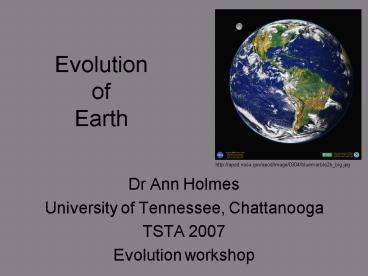Evolution of Earth PowerPoint PPT Presentation
1 / 60
Title: Evolution of Earth
1
Evolution of Earth
http//apod.nasa.gov/apod/image/0304/bluemarble2k_
big.jpg
- Dr Ann Holmes
- University of Tennessee, Chattanooga
- TSTA 2007
- Evolution workshop
2
Geologic Time Scale
Time Abbreviations k.y. thousand years
Ka m.y. million years Ma b.y. billion
years Ga
3
How do we know how old the Earth is?
- Scientists
- use radiometric dating to calculate age of 4.6
billion years - calculate comparable ages for Moon rocks,
meteorites and other Solar System fragments
4
Radioactive Decay Types
Alpha particle 2 protons and 2 neutrons emitted
Beta particle Electron is emitted
Gamma ray Very short wavelength EM energy is
emitted
5
Parent/Daughter Isotopes Half-life Ranges
6
Radiometric Dating
7
Radioactive Decay Carbon Example
Atmospheric Carbon Concentrations 12C 99 13C 01
14C trace amts
Carbon Isotopes 12C 6p 6n stable 13C 6p 7n
stable 14C 6p 8n unstable
8
Radioactive DecayUranium Example
238U 234Th ??? ?where ? is 2p and 2n)
9
U in Zircons
10
Formation of the Moon
- The Big Whack
- Occurred 4.5 billion years ago
- created the Moon
- caused Earth to melt and develop layers - core,
mantle and crust
http//starchild.gsfc.nasa.gov/Images/StarChild/qu
estions/moon_formation.jpg
11
Differentiation of Earth into Layers
Solid inner core Fe,Ni metal alloy
Plastic solid mantle Fe,Mg silicates
Liquid outer core Fe,Ni metal alloy
Brittle crust Fe,Mg silicates K,Al silicates
12
Earths Interior
http//www.fas.org/irp/imint/docs/rst/Sect19/Sect1
9_2a.html
13
Internal Structure of Earth
If the Earth was the same all the way
through, waves would look like this
But seismic waves from earthquakes actually look
like this. They refract as they pass through
different densities, changing their arrival
times.
14
Seismic VelocitiesDefine Earths Layers
15
Hadean
4507 - 4000 Ma
16
Early Earth Conditions - Hadean Eon
- Early Earth
- a very near moon
- strong tides
- pools of acid
- very hot conditions
http//www.palaeos.com/Hadean/Hadean.htm
17
Late Heavy Bombardment Period
3800-4000 m.y. Moon and 4 inner planets
affected. Dates confirmed by lunar impact-melt
rocks If LHB theory correct, Earth had serious
environmental damage/100 yrs.
http//space.newscientist.com/data/images/ns/cms/d
n12532/dn12532-1_650.jpg
18
Archean
3800-2500 Ma
19
Evolution of Atmosphere and Ocean
4200 - 3300 Ma
20
Precambrian Atmospheric Composition
http//www.fas.org/irp/imint/docs/rst/Sect19/Sect1
9_2a.html
http//www.fas.org/irp/imint/docs/rst/Sect19/Sect1
9_2a.html
21
Cratons
http//en.wikipedia.org/wiki/Craton
22
Archean Cratons - S. Africa
cratons
greenstone belts
23
Map of N. American Cratons
Archean orange Proterozoic green
http//higheredbcs.wiley.com/legacy/college/levin/
0471697435/chap_tut/chaps/chapter09-02.html
24
Archean Plate Tectonics
25
Chemotrophic bacteria
Deep thermal springs along a mid-ocean ridge
Thermal springs on the surface at Yellowstone
Filamentous pink chemotrophs
26
Chemotrophic Sulfate-reducing Bacteria
Sulfate reduction process, resulting in the
formation of biogenic sulfide
27
Photosynthetic Bacteria
28
Evolution of an Atmosphere
Cumulative history of O2 by photosynthesis
through geologic time.
29
Oxygen Holocaust in the Ocean
Note O2 bubbles
The culprit cyanobacteria
Modern stromatolites from Shark Bay, Western
Australia
http//commons.wikimedia.org/wiki/ImageCyanobacte
riaInPool.jpg photo by Christian Fischer
30
Microscopic Cyanobacteria
Modern cyanobacteria
Fossil cyanobacteria
Remnants of cell walls from billion-year-old
cyano-bacteria were found trapped inside oil
bubbles inside quartz crystal (Roper Basin
sandstone, Australia Image NIH, David Maddison)
Anabaena sperica
31
Banded Iron Formation
Late Archean Brockman Iron Formation of the
Pilbara Craton in western Australia (photo by
Hiroshi Ohmoto, Penn State)
Michigan
http//www.wmnh.com/wmel0000.htm
32
Banded Iron Formation - BIFs
33
An Oxygen-rich Atmosphere
34
Proterozoic
2500 - 543 Ma
35
Snowball Earth
RODINIA
Laurentia
Isotopically light C isotopes in (Ca,Mg)CO3
diamictite
http//www.snowballearth.org/week4.html
36
Global marine glacial strata
37
Paleolatitude of Marinoan glacial deposits
38
Arguments for Snowball Earth
Glacial tillites suggest glaciers all over the
world Paleomagnetism suggests that some of these
are at low latitude (near the equator) The
presence of tidal rhythmites in cap carbonates
indicate shallow ocean setting (not high altitude
glaciers like Kilamanjaro). Carbon isotopes are
light in cap carbonates, suggest a
photosynthesized source (12C vs 13C)
39
How did life survive Snowball Earth?
7 thick clear ice - N. Canada
http//www.trailconditions.com/vbforum/showthread.
php?t5291
- Marine refugia develop where ice cover is thin.
- Where ice is clear, light transmission to 20
meters. - Chemotrophic life still exists at hydrothermal
vents.
40
Cambrian
543 - 505 Ma
41
Shelly Fossil Evolution
Burgess shale, Walcott Quarry, near Field BC
Anomalocaris model and fossil mouth part
http//www.digitalbiology.com/
42
Ocean Chemistry Spreading Rates
43
Permian
286 - 248 Ma
44
Permian North America Paleogeography
Appalachian-Ouachita Mountain Chain
N. Am
Joined N. Hem. continents are called Laurentia
Africa
Joined S. Hem. continents are called Gondwana
S. Am
45
Pangaea
46
Evidence for Pangaea
Gondwana
47
Breakup of Pangaea
Canyon de Chelly, nw AZ
Rift valleys developing between Africa and N Am
2
1
2 - Triassic Shinarump Conglomerate 1 -
Permian de Chelly Sandstone
Dinosaur footprints CT rift basin
48
Cretaceous
144 - 65 Ma
49
Cretaceous North America
Western Interior Seaway
50
Cretaceous Global View
51
Cretaceous Warming
- High sea levels in the Cretaceous are likely
caused by several mechanisms - Thermal expansion of warm ocean water
- High seafloor-spreading rates
- All ice melted (no ice at either pole)
- Passive margin subsidence and other tectonic
effects - Volcanism adds 4-18x pre-industrial CO2
52
Taking the Temperature of the Past
H216O
H216O
shells
CaC18O3/CaC16O3
53
Quaternary
The last 2 million years
54
Surface Temp Variations
Blue curve is year by year Black curve is the
50-yr avg Grey area is 95 confidence interval
55
Vostok Ice Core
http//www.awi-bremerhaven.de/GPH/EPICA/
http//nicl-smo.unh.edu/icwg/1998/fig2.html
56
Holocene Overview
57
Thermohaline CirculationConveyor Belt
http//lithuanian.wunderground.com/education/abrup
tclimate.asp
58
Younger Dryas
http//lithuanian.wunderground.com/education/abrup
tclimate.asp
59
1000 Year Temperature Record
Little Ice Age
Medieval Warm
60
Keeling Curve

